
Olearia, most commonly known as daisy-bush, is a genus of flowering plants belonging to the family Asteraceae, the largest of the flowering plant families in the world. Olearia are found in Australia, New Guinea and New Zealand. The genus includes herbaceous plants, shrubs and small trees. The latter are unusual among the Asteraceae and are called tree daisies in New Zealand. All bear the familiar daisy-like composite flowerheads in white, pink, mauve or purple.
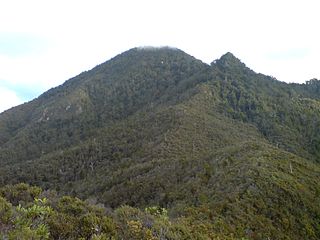
Mount Hobson is the highest mountain on Great Barrier Island, New Zealand. Located in the centre of the island, it rises 627 m (2,057 ft) above sea level.

Ixerba brexioides, the sole species in the genus Ixerba, is a bushy tree with thick, narrow, serrated, dark green leaves and panicles of white flowers with a green heart. The fruit is a green capsule that splits open to reveal the black seeds partly covered with a fleshy scarlet aril against the white inside of the fruit. Ixerba is an endemic of the northern half of the North Island of New Zealand. Common names used in New Zealand are tawari for the tree and whakou when in flower. It is assigned to the family Strasburgeriaceae.

Olearia hectorii is a species of flowering plant in the daisy family Asteraceae. Its common names include deciduous tree daisy and Hector's tree daisy. It is endemic to New Zealand, where it is nationally endangered.

Pachystegia insignis is a species of flowering plants in the family Asteraceae. It is endemic to New Zealand.
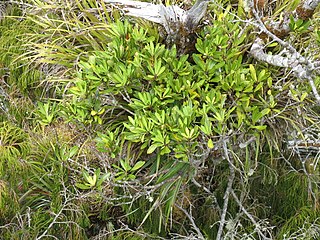
Pittosporum kirkii is a glabrous evergreen perennial shrub that reaches up to 5 metres (16 ft) in height and possesses distinctive coriaceous, fleshy, thick leaves. It is one of four shrubs endemic to New Zealand that frequently displays an epiphytic lifestyle. P. kirkii is commonly epiphytic, perched amongst nest epiphytes in the canopies of emergent or canopy trees in old-growth forest; however, it can be observed occasionally growing on the ground or over rocks. Kirk first observed P. kirkii on Great Barrier Island. It was described by Joseph Dalton Hooker from material collected by Thomas Kirk, possibly from the Thames Goldfields, and published in 1869. The initial brief description titled Pittosporum n. sp.? by Thomas Kirk was published in his paper on Great Barrier Island in 1868. This description along with herbarium specimens were sent to Dr. J. D Hooker at Kew Gardens in 1868, and he collaborated to name it after T. Kirk, by giving it the specific epithet kirkii within the publication that was otherwise written by Kirk.

Agriophara colligatella, also known as the Olearia Skeletoniser, is a moth of the family Depressariidae. It is endemic to New Zealand and is found on both the North and South Islands. This species inhabits native scrub. Larvae feed on the leaves of species in the genus Olearia during the months of November and December. They then pupate amongst the old flowers and leaves of their host plant. Adults have been observed on the wing from August to September but are most common in January. It has been hypothesised that this species overwinters as an adult as it has been observed on the wing in late autumn and early winter. Adults are attracted to light.

Pachystegia is a genus of shrubs in the family Asteraceae, known as Marlborough rock daisies, with distinctive leathery leaves and daisy-like flowers. They are naturally found only in dry areas of the north-eastern South Island of New Zealand.
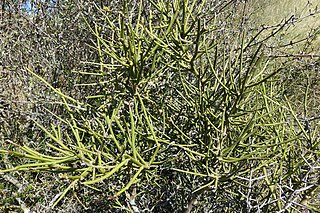
Carmichaelia petriei is a species of New Zealand broom in the genus Carmichaelia. It is endemic to New Zealand. C. petrieis is possibly a host plant for the critically endangered fungus weevil Cerius otagensis.

Pseudowintera traversii, sometimes called Travers horopito, is a species of woody shrub in the family Winteraceae. The specific epithet traversii is in honor of naturalist Henry H. Travers (1844–1928), son of William Thomas Locke Travers.

Olearia avicenniifolia, known commonly as mountain akeake, is a flowering plant in the family Asteraceae. It is endemic to New Zealand where it is found on the southern coastlines of the South Island and on Stewart Island. It is classified as Not Threatened.
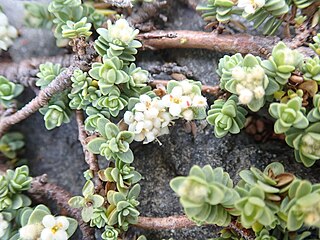
Pimelea urvilleana is a ground spreading shrub in the Thymelaeaceae family. There are two intraspecifics: Pimelea urvilleana subsp. nesica, and Pimelea urvilleana subsp. urvilleana.

Celmisia major is a species of daisy that is endemic to New Zealand. It is split into two different varieties, Celmisia major var. major and Celmisia major var. brevis. Despite being in the same species, it is thought that the two varieties are not close to one another, with botanist Peter James de Lange stressing critical study on the taxonomy of the daisies. It was first described by Thomas Cheeseman in 1925. The major variety is found in the Auckland area and nearby islands, while the brevis variety is confined to Mount Taranaki.

Myosotis colensoi is a species of flowering plant in the family Boraginaceae, endemic to the South Island of New Zealand. Thomas Kirk described the species in 1896. Plants of this species of forget-me-not are perennial rosettes with bracteate inflorescences and white corollas.

Myosotis amabilis is a species of flowering plant in the family Boraginaceae, endemic to New Zealand. Thomas Cheeseman described the species in 1906 based on specimens collected at Mt Hikurangi. Plants of this species of forget-me-not are perennial rosettes with ebracteate inflorescences and white corollas with stamens that are exserted.

Kunzea sinclairii, also known as the Great Barrier Island kānuka, is a flowering plant in the myrtle family, Myrtaceae and is endemic to Great Barrier Island in the Auckland Region, New Zealand.

Libertia flaccidifolia is a species of flowering plant in the family Iridaceae. The plant was first described by Dan Blanchon and J.S. Weaver in 2009, and is thought to be endemic to northern Rodney in the Auckland Region, New Zealand.

Senecio pokohinuensis, also known as the Mokohinau groundsel, is a species of flowering plant in the family Asteraceae. The plant was first described as a subspecies of Senecio repangae in 1998, and elevated to species status in 2022. It is endemic to the Mokohinau Islands of the Auckland Region, New Zealand.

The Auckland Region of New Zealand is home to numerous endemic flora and fauna. Many of these species have ranges restricted to the Waitākere Ranges, Great Barrier Island, Little Barrier Island and the Mokohinau Islands. A number of species have restricted ranges that include areas outside of the Auckland Region, such as Buller's shearwater and Pycroft's petrel, or organisms such as the brown teal / pateke and stitchbird / hihi which have recently increased ranges due to conservation efforts.
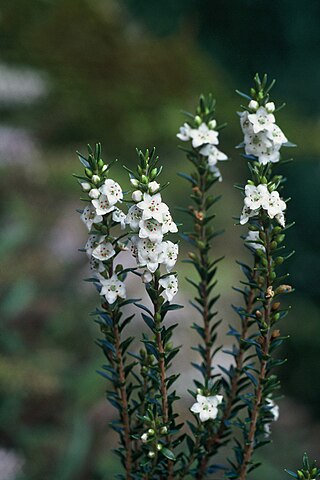
Epacris sinclairii, also known as Sinclair's tamingi, is a plant species in the family Ericaceae. The species is endemic to New Zealand, found exclusively on Great Barrier Island and the Coromandel Peninsula.

























